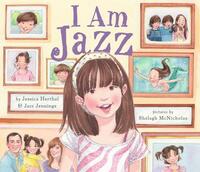You need to sign in or sign up before continuing.
Take a photo of a barcode or cover
I love Jazz’s autobiography and her story. This is a poorly made picture book.
I would almost recommend this to anyone who thinks the trans experience is confusing. It’s simply and elegantly explained. And I love how they never use Jazz’s deadname!
Another banned/challenged book that is perfectly fine.
Another banned/challenged book that is perfectly fine.
This is an excellent book to use with children or families to increase education (awareness) for transgendered youth.
I had some issues with this book.
1. Jazz is not white. So why is she white in the book?
2. Please don't use terms like "boy body" and "girl clothes." Don't enforce the binary and gender stereotypes on small children. Jazz is a girl, and therefor has a girls body. I understand all too well as a trans person with dysphoria myself being uncomfortable in one's body. That doesn't make my body a girl body. I'm not a girl.
3. I wish it had gone into a little more depth (it could've and still been for children) about what being trans means. That this is just one story, each story is important, but each story is also different.
4. And girls can like trucks and superhero's, boys can wear dresses. It ends up using the fact that Jazz likes dresses and being a princess as evidence for her being trans. It just reinforces gender stereotypes. There is nothing wrong with being a feminine girl, there is something wrong with saying to be a girl means to be feminine. You see what I mean.
And apparently this was written by 2 white cisgender women? I know people can write "stuff outside their lane" but I really think trans authors would have handled this better.
2 stars. I liked the message of accepting your child for who they are. That's always a good message.
1. Jazz is not white. So why is she white in the book?
2. Please don't use terms like "boy body" and "girl clothes." Don't enforce the binary and gender stereotypes on small children. Jazz is a girl, and therefor has a girls body. I understand all too well as a trans person with dysphoria myself being uncomfortable in one's body. That doesn't make my body a girl body. I'm not a girl.
3. I wish it had gone into a little more depth (it could've and still been for children) about what being trans means. That this is just one story, each story is important, but each story is also different.
4. And girls can like trucks and superhero's, boys can wear dresses. It ends up using the fact that Jazz likes dresses and being a princess as evidence for her being trans. It just reinforces gender stereotypes. There is nothing wrong with being a feminine girl, there is something wrong with saying to be a girl means to be feminine. You see what I mean.
And apparently this was written by 2 white cisgender women? I know people can write "stuff outside their lane" but I really think trans authors would have handled this better.
2 stars. I liked the message of accepting your child for who they are. That's always a good message.
emotional
hopeful
informative
inspiring
fast-paced
This was a cute story told from the perspective of Jazz Jennings as a little girl. It was written by another person, but she clearly used details from Jazz's life to tell her story. This book is a great way to help a young person understand what it means to be transgender. There aren't too many words on each page and the words are not too complicated, so I could see grades K-3rd enjoying reading this book. This book could be read to all ages to help them understand what it's like for someone who is transgender to feel like they don't belong in their own body and that people are forcing them to act in ways that don't match how they feel on the inside.
Readers who would enjoy this book are: people who like reading books about real people they have seen on tv, people who like reading books about members of the LGBTQIA community, and people who like reading stories about families.
Readers who would enjoy this book are: people who like reading books about real people they have seen on tv, people who like reading books about members of the LGBTQIA community, and people who like reading stories about families.
I appreciate that this is the story of a real person. I remember when the news blew up over Jazz, and I remember what my mom thought about transgender. I'm a bit older than Jazz, but I was still a kid when she and her parents were being torn into by people like my mom.
The thing that I don't really like about this picture book is that I think "When Aiden Became a Brother" by Kyle Lukoff explains transgender better than I Am Jazz does. I Am Jazz tends to enforce black-and-white stereotypes of what is appropriate for girls to like, and what is appropriate for boys. My sister and I shared GI Joe dolls and Barbies. We played with firetrucks in the mud and also both did gymnastics and ballet. I'm pretty confident in my identity as female, even though I don't particularly care how other people perceive me (I do get called "sir" a lot by people who just see my short hair haha).
The thing with gender identity is it isn't black and white, based on your preferences. Girls can play with GI Joe, boys can play with baby dolls. Girls can wear cargo shorts, and boys can wear makeup. Anyone can have their hair as long or short as they like. Boys can be professional ballet dancer. Girls can be plumbers or carpenters. Anyone can shave their armpits or let the hair be wild and free. Just because you dress certain ways, like certain things, or participate in certain practices doesn't say anything about your gender identity really... Your gender identity is how you perceive yourself, and others need to respect that.
Idk. I feel like this picture book just kind of contradicts what I just read a few minutes ago in "When Aiden Became a Brother" and "An Equal Shot: How the Law Title IX Changed America."
The thing that I don't really like about this picture book is that I think "When Aiden Became a Brother" by Kyle Lukoff explains transgender better than I Am Jazz does. I Am Jazz tends to enforce black-and-white stereotypes of what is appropriate for girls to like, and what is appropriate for boys. My sister and I shared GI Joe dolls and Barbies. We played with firetrucks in the mud and also both did gymnastics and ballet. I'm pretty confident in my identity as female, even though I don't particularly care how other people perceive me (I do get called "sir" a lot by people who just see my short hair haha).
The thing with gender identity is it isn't black and white, based on your preferences. Girls can play with GI Joe, boys can play with baby dolls. Girls can wear cargo shorts, and boys can wear makeup. Anyone can have their hair as long or short as they like. Boys can be professional ballet dancer. Girls can be plumbers or carpenters. Anyone can shave their armpits or let the hair be wild and free. Just because you dress certain ways, like certain things, or participate in certain practices doesn't say anything about your gender identity really... Your gender identity is how you perceive yourself, and others need to respect that.
Idk. I feel like this picture book just kind of contradicts what I just read a few minutes ago in "When Aiden Became a Brother" and "An Equal Shot: How the Law Title IX Changed America."
I thought this was like any other children picture books. Cute illustrations and simple heartfelt story. But it wasn’t!
So, Jazz was born a boy. But the thing was she didn’t like boy’s stuff and liked girls stuff, not only that she even recognized herself as a girl. There’s actually a term for this condition, it is called gender dysphoria.
“Pretending I was a boy felt like telling a lie.”
Then, her parents brought her to a doctor and the doctor told them that she was a transgender. After that, her family started accepting her as a girl, as a trans. The story didn’t stop there, tho. I mean, some of her friends sometimes still called her names. They called her name when she was a boy.
The story portrays a little kid’s confused emotions about gender identity and biological sex—how they want people to identify them as girls when physically they are boys, and vice versa. As a society, it is our role to understand and to be more accepting about this issue. Even if you can’t accept it, do it for those children. Those children are yours to begin with (for parents).
5/5
So, Jazz was born a boy. But the thing was she didn’t like boy’s stuff and liked girls stuff, not only that she even recognized herself as a girl. There’s actually a term for this condition, it is called gender dysphoria.
“Pretending I was a boy felt like telling a lie.”
Then, her parents brought her to a doctor and the doctor told them that she was a transgender. After that, her family started accepting her as a girl, as a trans. The story didn’t stop there, tho. I mean, some of her friends sometimes still called her names. They called her name when she was a boy.
The story portrays a little kid’s confused emotions about gender identity and biological sex—how they want people to identify them as girls when physically they are boys, and vice versa. As a society, it is our role to understand and to be more accepting about this issue. Even if you can’t accept it, do it for those children. Those children are yours to begin with (for parents).
5/5
emotional
sad
slow-paced
informative
lighthearted
Quickly read this at the library because I had a 15 min wait for my ride. I definitely will re-read it to have a clearer review because the other reviews I've read are very valid criticism of the book. However, I do believe this is a good beginner's guide to teaching kids about transgender people and in this case, a trans girl.
This briefly goes over Jazz's childhood to seeing a therapist and eventually, coming out and socially transitioning. Though, it does show a stereotypical experience because not every trans person will know from childhood (or have the words), and not every trans kid will play with toys society has gendered (i.e. girls play with dresses, boys play with trucks). But, this is just one person's experience and that is valid!
I would've liked to have seen other trans people in this book to show different trans kids' experiences. I would recommend it but also say to seek out other trans children's books to read about the different experiences.
This briefly goes over Jazz's childhood to seeing a therapist and eventually, coming out and socially transitioning. Though, it does show a stereotypical experience because not every trans person will know from childhood (or have the words), and not every trans kid will play with toys society has gendered (i.e. girls play with dresses, boys play with trucks). But, this is just one person's experience and that is valid!
I would've liked to have seen other trans people in this book to show different trans kids' experiences. I would recommend it but also say to seek out other trans children's books to read about the different experiences.





